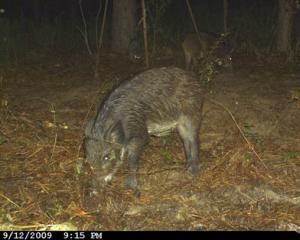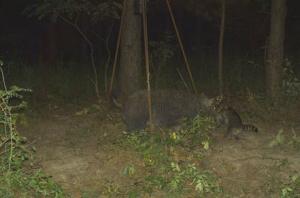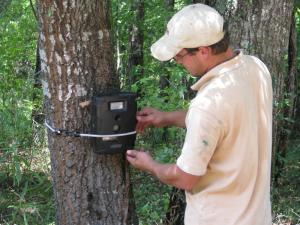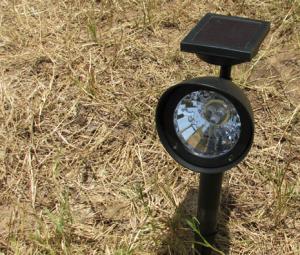‘Hog Cam’ Could Give
Upper Hand on Feral Hogs
New, inexpensive automatic cameras best weapon in feral-hog war.
Know your enemy better than your friends, the saying goes.
As for feral hogs, knowing when, how many and where they visit is critical to controlling them, said a Texas AgriLife Extension Service expert.

And one of the best ways to monitor feral hog activity, either with trapping or hunting in mind, is by using remote-sensing cameras, said Billy Higginbotham, AgriLife Extension wildlife and fisheries specialist.
In Texas, feral hogs cause an estimated $52 million in damage to crops and pastures annually, he said. "And that does not include damage to
wildlife food plots, wildlife feeds and
feeders, or to recreational areas like
parks, golf courses and landscapes."

From the standpoint of either recreation or economics, the impact of feral hogs on deer hunting in Texas is large, he said. Deer hunting has an economic impact of more than $2 billion dollars annually, and feral hogs compete with white-tailed deer for food and territory throughout their habitats.
"Feral hogs are impressive adversaries," he said. "They're smart and wary of both hunters and traps. Remote-sensing cameras can swing the advantage to the side of hunters and trappers trying to abate damage."
The film cameras of 20 years ago were tripped electronically, either by motion or infrared sensors, he said. The digital cameras of today are weatherproof and easier to set up. And in the past few years, prices have dropped significantly, with entry-level cameras costing about $80 and higher-end cameras in the range of $600, with many options in between.
 "The utility of these little devices extends well beyond patterning deer," Higginbotham said. "Their capability to record the date and time of events captured digitally is what makes them especially useful for combating feral hogs."
"The utility of these little devices extends well beyond patterning deer," Higginbotham said. "Their capability to record the date and time of events captured digitally is what makes them especially useful for combating feral hogs."
For trapping, when the landowner spots a herd of feral hogs, called a "sounder," or finds damage, he or she can put out shelled corn as bait and set up a camera to monitor activity. By taking a head count of the sounder, the landowner can determine the best size trap to put out.
"The idea is to have a trap large enough so the last hog enters through the gate before the first hog trips the gate trigger, usually located near the back of the trap," Higginbotham said. "Maximizing the distance between the gate and trigger means using bigger traps if large numbers of hogs make up the sounder."
Higginbotham recommended using a camera to continue monitoring hog activity long after the trap is erected.
"It may take several days or even a week or more for the hogs to become accustomed to the freshly erected trap. Pre-baiting both outside and inside the trap toward the trigger mechanism should continue. Once the hogs are regularly entering the trap to feed, you can set the gate to trip — based on camera data — and be confident that you will catch hogs."

As for removing feral hogs with firearms or bows, using the cameras in conjunction with solar-charged spotlights is highly effective, Higginbotham said.
As with trapping, the strategy is to use shelled corn or soured grain as bait, and then set up a camera to determine the patterns of their visits. A blind is erected downwind of the bait sites. Solar powered spotlights are set on T-posts to illuminate the bait.
"The spotlights are the key," Higginbotham said. "If you leave them on continuously, the hogs get used to them."
Hogs are primarily nocturnal, visiting the bait sites between dusk and dawn, Higginbotham noted.
"The spotlights are placed so they point away from the blind to avoid creating glare," he said.
Landowners have successfully used this technique with both rifles, crossbows and compound bows, Higginbotham said, but noted there are some definite advantages to using a bow.
"Unlike firearms, the use of bows does not frighten the hogs, allowing for multiple removals in some instances," he said.
The rest of the sounder, particularly the large boars, will often stay around the bait allowing for more to be taken.
Also, there's no gun report to disturb neighbors, he said.
Removing hogs with firearms or bows at night is legal in Texas, Higginbotham noted. "But a courtesy call to the local game warden is recommended to those planning on discharging firearms after dark."
Higginbotham said he knows of instances where this technique allowed the removal of as many as three boars at the same site the same night, and boars will often come back night after night.
Sows tend to be more wary, he said. All large sows in a sounder must be taken the same night or they may not revisit the bait site for weeks, he said.
"Rather than spending hours swatting mosquitoes and missing sleep, the cameras allow the landowner to pattern hog activity and concentrate their time afield when it really counts," Higginbotham said. "The goal is to abate damage to agricultural enterprises, so maximizing efficiency is the key to trapping and shooting marauding feral hogs."




